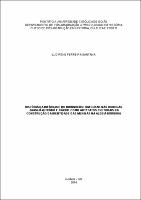| Compartilhamento |


|
Use este identificador para citar ou linkar para este item:
http://tede2.pucgoias.edu.br:8080/handle/tede/3338| Tipo do documento: | Dissertação |
| Título: | HISTÓRIA DA INFÂNCIA E DO BRINQUEDO: UM OLHAR NAS BONECAS KARAJÁ-RITXÒKÒ E BÁRBIE COMO ARTEFATOS CULTURAIS NA CONSTRUÇÃO DA IDENTIDADE DAS MENINAS NA ALDEIA BURIDINA. |
| Autor: | Gualberto, Lucirene Ferreira Santana  |
| Primeiro orientador: | Reinato, Eduardo José |
| Primeiro membro da banca: | Nascimento, Renata Cristina de Sousa |
| Segundo membro da banca: | Correia, Paulo Petronilio |
| Resumo: | Esta pesquisa busca contribuir com a produção acerca da História da Infância e do Brinquedo: Um olhar nas bonecas Karajá-Ritxòkò e Bárbie como artefatos culturais na construção da identidade das meninas na Aldeia Buridina. Tendo como eixo três objetivos centrais: estudar a história da infância, dos brinquedos, das brincadeiras e as relações com as meninas indígenas na Aldeia Buridina em Aruanã GO. Trazer ao conhecimento acadêmico e da população de modo geral, a história da boneca Karajá- Ritxòkò e as formas de expressão como Patrimônio Cultural Imaterial do Brasil. Compreender as condições históricas que possibilitaram um fortalecimento da identidade étnica e interétnico nesta comunidade a partir do fomento na produção da boneca de cerâmica e a inclusão da boneca Bárbie nas brincadeiras das meninas. Inicialmente a pesquisa foi norteada pela compreensão das correntes historiográficas, com ênfase na História Cultural e sua relação com o objeto desta pesquisa. Simultaneamente foi realizada uma pesquisa sobre brinquedos e brincadeiras, em que se priorizou o estudo das bonecas de cerâmica Karajá Iny e a boneca industrializada Bárbie. Envolta em um mundo de beleza, riqueza e aventura, a boneca Bárbie está imersa em uma pedagogia cultural, com o intuito de ensinar a supremacia de um tipo de corpo, raça e comportamento do consumo. A boneca de cerâmica carrega em seu corpo elementos da cultura indígena, a pintura dos grafismos perfaz o processo de produção das figuras em cerâmica pelas mulheres, articula o mundo simbólico karajá e revela igualmente um processo criativo próprio, decorrente de fatores exteriores como aqueles atribuídos pelo contato interétnico. Foi realizada uma pesquisa bibliográfica e os principais teóricos foram Le Goff (1990) ,Braudel(1961) ,Peter Burke(2008) ,Áries (1981) ,Kuhlmann Jr.(1998) ,Gélis (1991) ,Clifford Geertz( 2004) Brougère(2004) , Walter Benjamin(1987).A metodologia foi pesquisa bibliográfica e de campo. |
| Abstract: | This research aims at contributing to the production about the Childhood and toys history: a reflection on the Karajá - Ritxòkò doll and the Barbie doll as cultural manufactures in the formation of the girls identity at the Aldeia Buridina (Buridina Indian settlement). It has as a main idea three central goals: (1) studying the history of childhood, toys, jokes and the relationships among-with Indian girls in the Indian Settlement (Aldeia Buridina), in Aruanã GO,(Brazil);(2) introducing into academic community s knowledge, and also in population altogether, the question of the Karajá- Ritxòkò doll, besides the expression forms as a Brazil s immaterial cultural patrimony (domain);(3) to understand the historical conditions that made possible the strengthening of ethnical andinterethnical identity in such community, through fomentation in manufacturing the doll in ceramics matter and the inclusion of the Barbie doll into the girls recreations. Initially the research has been directed by the comprehension of historic graphical streams emphasized on cultural history and his link with the focus of this research. At the same time, a search on toys and jokes has been established, in which the study of Karajá-Ritxòkò ceramics doll should get priority together with the American industrialized doll Barbie. Involved in a world of beauty, fortune and adventure, the Barbie doll is immersed in a cultural pedagogy aiming to teach the greatest value of a kind of body, race and consumption conditioning-behavior, the ceramics doll carries elements of Indian culture on its body; the painting of a set of lines drawn and pictures(with meaning) made to accomplish the process of production of pictures in ceramics by women, articulate the symbolic Karajá world and also a creative and proper process derived from external factors as well as those ones attributed by interethnic contact. A bibliography search was made, and the main theoreticians wearable Goff(1990),Braudel(1961),Peter Burke(2008), Ariès(1981),Kuhlmann Jr.(1998),Gélis (1991),Clifford Geertz(2004),Brougère(2004), Walter Benjamin(1987). The methodology consisted in bibliography and field searching. |
| Palavras-chave: | Infância Brinquedos Brincadeiras Meninas Indígenas Childhood Toys Jokes Indian girls |
| Área(s) do CNPq: | CNPQ::CIENCIAS HUMANAS::HISTORIA |
| Idioma: | por |
| País: | BR |
| Instituição: | Pontifícia Universidade Católica de Goiás |
| Sigla da instituição: | PUC Goiás |
| Departamento: | Ciências Humanas e da Terra |
| Programa: | História |
| Citação: | GUALBERTO, Lucirene Ferreira Santana. HISTÓRIA DA INFÂNCIA E DO BRINQUEDO: UM OLHAR NAS BONECAS KARAJÁ-RITXÒKÒ E BÁRBIE COMO ARTEFATOS CULTURAIS NA CONSTRUÇÃO DA IDENTIDADE DAS MENINAS NA ALDEIA BURIDINA.. 2014. 173 f. Dissertação (Mestrado em Ciências Humanas e da Terra) - Pontifícia Universidade Católica de Goiás, GOIÂNIA, 2014. |
| Tipo de acesso: | Acesso Aberto |
| URI: | http://localhost:8080/tede/handle/tede/3338 |
| Data de defesa: | 20-Nov-2014 |
| Aparece nas coleções: | Mestrado em História |
Arquivos associados a este item:
| Arquivo | Descrição | Tamanho | Formato | |
|---|---|---|---|---|
| LUCIRENE FERREIRA SANTANA.pdf | 5,53 MB | Adobe PDF |  Baixar/Abrir Pré-Visualizar |
Os itens no repositório estão protegidos por copyright, com todos os direitos reservados, salvo quando é indicado o contrário.




